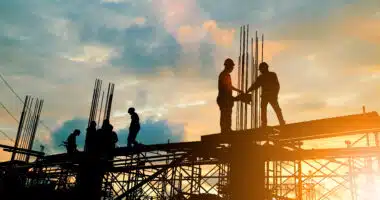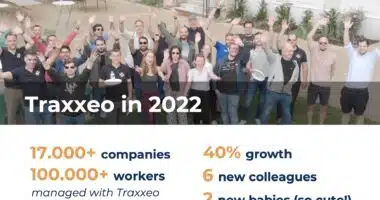Helping the construction industry to come back stronger after COVID-19

The coronavirus, or COVID-19, global pandemic is having a monumental effect on millions of people and businesses across the world. While it might be hard to imagine right now, things will hopefully return to some sort of normality eventually. This blog explores what construction companies can do now in difficult circumstances to help ensure that they come back stronger after the crisis.
The effects of the COVID-19 crisis grow and spread on a daily basis. Thousands of people are dying, health services are being inundated, our movements are being restricted to try to slow the spread of the virus, businesses are going bankrupt, people are losing their jobs – the list could go on and on. In fact, it might be quicker to just say that everyday life as we knew it a few months ago has stopped. But while it isn’t the prime concern of everyone, understandably, it is nevertheless inevitable – and desirable – that some people in construction are looking to the future.
COVID-19 and the construction sector
Like most other sectors, construction is being massively affected by the pandemic. The situation is changing on a daily basis – and usually for the worse – which means that numbers and predictions soon become outdated. Nevertheless, The Brussels Times has written that “A quarter of Belgian companies are likely to experience severe problems, should they have no income for two months […] The construction and chemical sectors […] could also suffer because of the measures taken to contain the pandemic.” In Italy, the construction sector is predicted to contract by 0.7% in 2020. Looking more widely, it seems that the outlook is not very positive for economies across the world, wherever you look.

The specific problems arising include – but are by no means limited to – workers becoming ill (or worse) and having to self-isolate, worksites and offices closing down with some staff working from home where possible, border controls being put in place, supply chains creaking under pressure, redundancies and layoffs occurring, and cashflows starting to dry up.
Focusing on the longer-term future, there are some notable challenges that the construction sector will face in the coming months and years:
- A reduction in income due to winning fewer projects. Future investment and development plans are being delayed or cancelled.
- The need for project cost adaptation and a rethink of resource allocation.
- Long-term economic unemployment for workers.
- Difficulties in maintaining a minimum service.
Tough times clearly lay ahead for all, but there are still ways to try to deal with the current situation and plan for the future.
Taking action to cope with the pandemic
The current health emergency has seen urgent public infrastructure projects being drawn up at very short notice (for example, hospitals in China and England), which will provide some much needed stimulation to the sector, albeit on a relatively small scale and likely to only be in the short term. But for most companies, the outlook is one of work shutting down. Governments are putting measures in place to try to mitigate the financial impacts on business, but the scale and pace of the crisis mean that it is still having an unprecedented effect. However, companies are not completely helpless and can take actions to try to cope with the pandemic and ensure that they are fit for the future.
Optimise your daily work now to hit the ground running tomorrow
Charles le hodey – VP GROWTH @ TRAXXEO
At this point it must be stressed that the purpose of this blog is not to focus on the very significant health aspects of the virus – there are numerous official sources where good information is available. However, it is important to emphasise that the first priority is obviously to follow government and healthcare advice to ensure the health, safety and wellbeing of personnel. But looking more broadly at the operational aspects of the construction sector, there are several opportunities for innovation while working remotely that might prove beneficial in the long term:
- Rework or update internal documentation and processes related to the awareness of sensitive topics such as security, safety and compliancy. Tools such as Miro and Google Slides will allow you to collaborate remotely on this.
- Improve the methods of collaboration between different construction partners thanks to modern tools such as Skype, FieldChat (“Messaging built for construction teams”), LetsBuild (“We connect construction”) and Slack.
- Work on improving: (a) the internal processes linking worksites to offices using digital tools (e.g. tracking, on-site monitoring, remote site management, etc), and (b) customer relationship management (CRM) tools that you already use internally in order to exploit their full potential.
- Communication is always crucial and this is certainly a time to ensure that it continues. For example, boost the trust of your internal and external partners by launching a customer satisfaction survey in order to understand their issues and areas for improvement through survey tools such as Google Forms, Typeform and SurveyMonkey.

The ways that we all do business will inevitably evolve over time, but it is possible that COVID-19 will speed up this process and we might see a phase of rapid developments, such as new relationships with customers, increased remote working, more creative ways of working together and changes to supply chain strategy. Standing still and hoping for the best is unlikely to be a very successful long-term approach.
An opportunity to innovate
The COVID-19 crisis is a global pandemic that will clearly have repercussions for businesses for many years. Aside from ensuring the ongoing health and wellbeing of their staff, construction companies can use this large-scale interruption to business activities to change established habits and processes that have evolved to be inefficient or ineffective. The suspension of construction activities on-site for what might be a lengthy period could provide the ideal opportunity to rethink strategies and to implement modern tools in order to break out of an inefficient cycle.
Being flexible and adaptable are essential characteristics during a crisis. Additionally, innovation should be embraced at this time, rather than deferred until later as instinct might suggest. Maintaining some form of productivity in a period of inactivity is key to keeping ahead and, above all, to being well-prepared for when normal activity finally resumes once again.
Other content that might interest you

The Construction Barometer 2023
The construction industry was forced to navigate through periods of unprecedented upheaval and transformation, profoundly changing the landscape for the…

The 6 trends to watch for in the construction industry…
From new construction modes to continuous inflation, which trends are going to shape the construction industry in 2023? While the…

From 2022 to 2023: Traxxeo builds the network of construction…
2022 have been a pivotal year for the construction sector: rising material prices, competitive pressure… To face the difficulties, construction…
Join more than 10,000 experts
Sign up to receive our most popular resources as well as other premium content to help you become more productive and profitable.